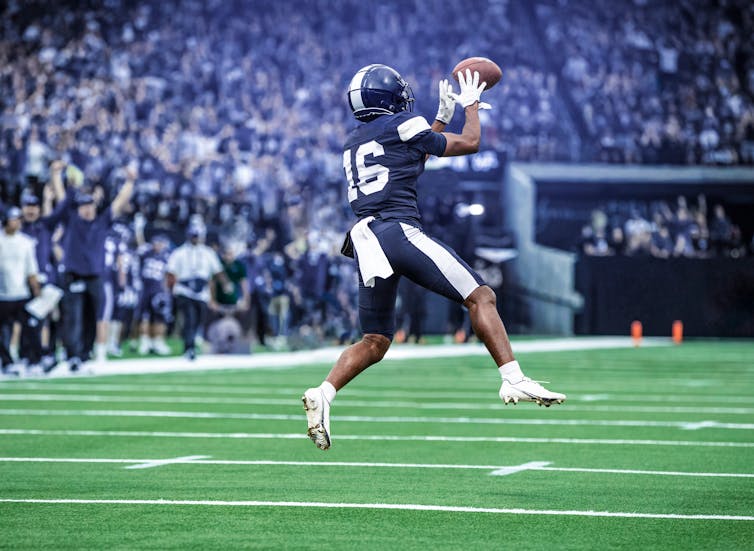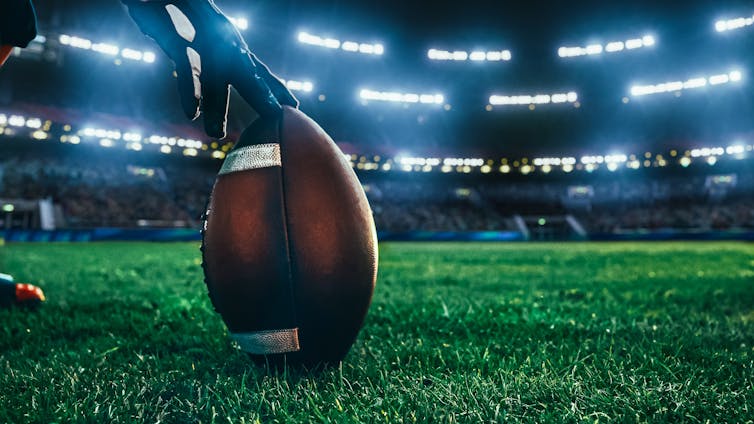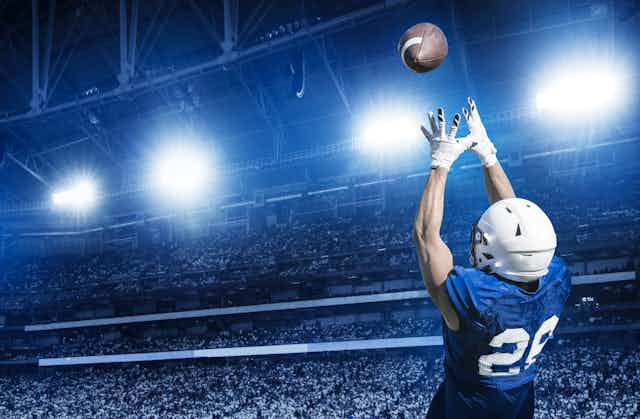With 113 million viewers in the United States and 40 million more around the world, the Super Bowl is the most popular sports event in North America. This year’s event on Sunday – with the added attraction of a romance in the spotlight – promises to attract as many fans.
In Canada, the most recent Grey Cup final, last November, reached a record audience of 3.7 million viewers who tuned in to watch the Montréal Alouettes’ victory.
The two leagues definitely don’t enjoy the same popularity – far from it. Nor do they have the same rules. But there is another difference: although similar in appearance, the famous oval balls used in football have specific characteristics on both sides of the border that can affect their aerodynamics, i.e. the forces exerted by the air on the ball during its flight. The design and characteristics of the ball have an impact on the magnitude of these forces.
It might be news to football players, but their talent for throwing balls long distances is not the only thing that matters. A number of factors affect the ball’s aerodynamics, including the way it is made and its inflation pressure.
As a professor in the Department of Mechanical Engineering at Québec’s École de technologie supérieure, I am interested in experimental fluid dynamics. I study the physics of fluid flows and certain applications (e.g. propulsion of aquatic vehicles, aerodynamic applications). Fluid dynamics is a vast field and affects many aspects of our lives, such as the flow of blood in the heart, the flight of aircraft, the beautiful swirling patterns in Jupiter’s atmosphere or the perfect football pass for a touchdown.
Ball size affects flight stability
The NFL and CFL have the same rules regarding the dimensions of their balls. They must be between 11" and 11.25" long. They must also be inflated to between 12.5 psi and 13.5 psi, giving them a maximum circumference of between 28" and 28.5" around the length and between 21" and 21.25" around the width.
These dimensions are important. The football acts like a gyroscope. The higher the speed of rotation, the more stable the ball will be during its flight. Different dimensions can therefore have specific effects on the stability of the ball’s flight.

A larger circumference suggests that more of the ball’s mass is located away from its centre line. This means that it will have a higher moment of inertia (resistance to rotation) and, therefore, that the same force applied to make it rotate will result in a lower speed of rotation.
Two stripes and laces make a difference
While there are two white stripes on the Canadian ball, as well as laces, American rules don’t mention these.
The differences between the Canadian and American balls can have an effect on their drag. A drag force is the resistance to a moving object in a fluid. In this case, it is mainly the resistance caused by the air (a fluid), which is called form or pressure drag.

Let’s take the example of a golf ball. Its dimples encourage turbulence, which allows the airflow to stick to the ball and reduce its total drag. Less drag means the ball can fly further with the same force applied.
The laces on a football and any other significant modification to its surface (a logo, a valve), in combination with the rotation of the ball, will to some extent have the same effect. It would be interesting to study how these differences between NFL and CFL footballs affect their respective drag.
NFL or CFL, which ball is better?
To do this, we could use a wind tunnel (an experimental installation in the form of a tunnel with a controlled airflow) to simulate the movement of air (fluid flow) around the two balls that will be fixed in space, put into rotation and subject to an airflow speed that would imitate the balls’ speed of flight.
An aerodynamic force balance could be used to measure the differences in drag between the two balls subjected to the same conditions. Ideally, to eliminate other factors of variability, the two balls would have the same dimensions.
The passage of air around the ball could be visualized using smoke or particle image/tracking velocimetry. The latter is a method in which the air is seeded with particles (helium-filled soap bubbles or oil droplets). The movement of these particles could then be captured using a camera to quantify the airspeed at all points around the ball. This would allow regions of flow separation and recirculation to be seen, and provide an idea of the distribution of aerodynamic forces around the ball.

Different rotation speeds and flight speeds could be examined, as there is always the possibility of developing flow instabilities, which would lead to a change in its behaviour around the ball.
This would help determine whether the NFL or CFL ball is better.
Ball texture influences drag
There is another type of drag, this one attributable to the friction between the air and the surface of the ball. This is called friction drag.
It depends mainly on the texture of the ball and its speed. The rougher the texture of the ball, the greater the friction drag for the same speed. Similarly, a faster ball speed will have a higher friction drag.
By reducing the form drag, we further reduce the total drag of the ball, which can therefore go further and faster on the football field.
And then there’s the weather!
The weather also plays a role in the aerodynamics of the football.
Cold or hot temperatures can affect the size of the ball by reducing or increasing the air pressure inside it.
Similarly, temperature can have some effect on the material properties of the ball, with colder temperatures making it stiffer and warmer temperatures making it softer.
Temperature and humidity also play a role in the physical properties of air, altering its density and viscosity.
Rain will also directly affect drag as, in a sense, it affects the texture of the ball’s surface as felt by the air.
But that won’t be an issue in Las Vegas on Feb. 11 for the Super Bowl game, since Allegiant Stadium is covered.


